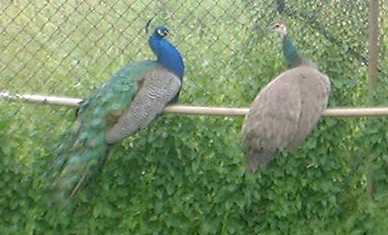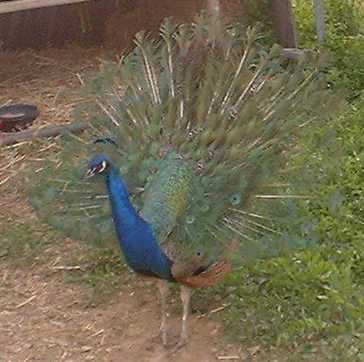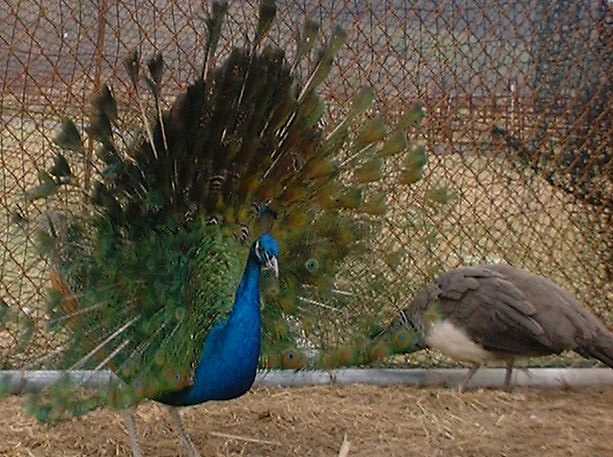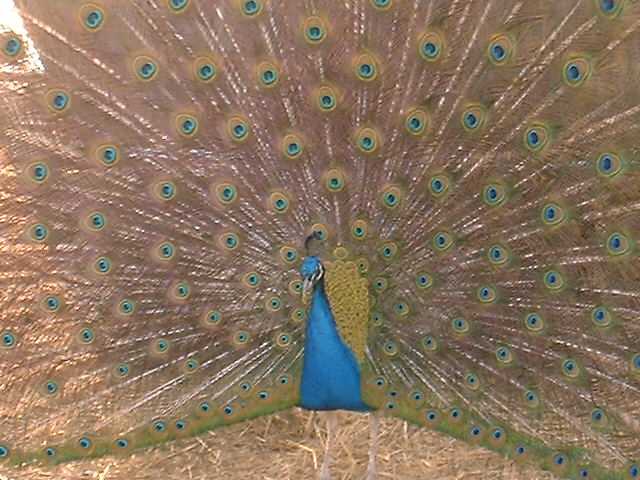Pete and Polly



Before we got them, Pete and Polly had lived almost their whole lives in a barn. So when they came to our place, being in an open pen outside got them quite upset. For the first few months we had them they were completely paranoid. Whenever we would drive even relatively nearby them on a tractor or a lawnmower they would really freak out and start running frantically. Whenever a person went near them, they would begin to pace back and forth the width of their pen. Back and forth, back and forth. It was quite boring and incredibly annoying. Finally they began to adapt to the outdoors and would pace less and less. Then one day my mom said she had seen Pete spread out his feathers. I was so excited!

I rushed right out and started watching. An hour later I returned to the house defeated with frozen hands but without a memory of seeing my peacock display its feathers. About a week later my mother once again remarked about seeing Pete showing off, but no matter how many times I tried I couldn't see him do it. But then one day in March, my friend Lindsay and I were driving past the peacock pen in my mom's Gator and caught Pete with his feathers up. He lowered them as soon as he saw us, but that split second really made my day. Soon I again caught Pete, and when I came over to watch he kept his feathers up for a few minutes before he began to act all scared again. Since then he began displaying his train more and more and until he was doing it almost constantly. Now he will let anyone watch him, and he will even start up when someone is around, and he will continue even if someone is in the cage with him.
When Pete spreads his feathers he vibrates them rapidly, and it sounds really strange. It's rather loud, and if I am visiting an animal in a nearby pen I am alerted to his mood by this sound. Once he's lifted his feathers he starts advancing towards Polly, who almost always walks away uninterested, or just ignores him completely. Sometimes during this process Pete starts walking backwards and once he began to climb up the roof of his shelter without noticing it. Although Polly almost never responds, the neighboring animals do, especially the ducks, who get near to the fence and begin quacking. Once my brother saw Polly raise her tail feathers, although I haven't seen her do this.

As you can see in the above picture, Pete's plumage was not spectacular the first year we had him because he was just slightly over 2 years old and had his first train. Therefore his feathers were not as long as mature peacocks' and he only had about 15-20 "eyefeathers" and most lacked the trademark peacock blue color in the center. However, now that he is in his fourth year, he is begining to regrow his feathers and they are much more impressive because he is now four years old and fully mature. Even though his train will continue growing for at least two more months, he already has more ocelli, or eyespots, than he did last year.
Pete soon began to make a call when he was trying to court the female. My mother often says that it makes it sound like we live in a jungle. My little brother likes to mimic this noise, which gives everyone in the family a headache. But I find the actual sound quite amusing. Durind mating season, he was making this noise often, but now he only does it occasionally. If only my brother would do the same example...
In mid-May 2000, Polly began to lay eggs. One night we were having a giant thunderstorm, and my mom was feeding the peacocks and out popped an egg. Although at first we were going to let Polly raise a nest, after two or three eggs were lost to the rats we decided to collect them and attempt to hatch them artificially. She began to lay them once a day, or sometimes every other day. The first eggs were due to hatch on June 26th. However, we had serious doubts about these eggs being fertile, and they came true because the first eggs did not hatch. Although peahens can mate at age two, it usually takes an older, more experienced male, which Pete is not. Also, artificial incubation of peacock eggs is tricky, and not always successful, especially on the first try. After it was positive that the eggs were not going to hatch, we checked to see if any peachicks had begun to grow. They eggs were empty. Polly had later laid a few more eggs, and since Pete has been fanning and strutting very often, I was hoping that this new batch would be fertile. But candling didn't show anything in the eggs, and they didn't hatch. It seemed that I was going to have to go another year without peachicks.
Lately I have been working on making Pete friendly, however it isn't working well. I sit in with him in his pen everyday and bribe him with dogfood. He will get very close, especially if I look in the opposite direction, and there has been many times when I could have reached out and touched him in the chest. However, I didn't because I don't want to scare him. But I have touched the end of his tail twice before he ran away. The first time frightened him a little, but he came back to me, although not as close. The second time I touched him, I stroked his feathers for about 2 seconds before he realized I was touching him, then he jumped in the air and ran in the other direction. I want to keep working on him and Polly too so that they will become more friendly and will come really close and maybe even eat out of my hand. But I'll beginning to think that this may be a lost cause and will most likely give up soon and instead work on my younger peacocks.
In 2000 Pete's tailfeathers began to fall out in June, and they didn't finish until late August. It really took him a long time to get rid of them, especially since I've heard that with some birds they all fall out in a day or two. Of course he chose to lose the majority of his feathers the two weeks I was on vacation, which also happened to be the two rainiest weeks we had had in a while. During this time Pete and Polly also lost a lot of other feathers from their wings, neck, chest, and back. I have never before realized how many different shapes and colors of feathers can come off of two birds.
I have recently discovered one of Pete and Polly's pet (literally) peeves. I was inside their pen spending some time with them when Chocolate, one of our bunnies, hopped into their pen. (We at the time had nine young rabbits, Chocolate being one of them, and when they outgrew our rabbit hutches my mother built a pen for them, which they soon dug out of, and then roamed the farm.) He hopped rather close to the peacocks, and began to eat some grass. Polly slowly started walking towards him, and he hopped away from them. Polly followed him again. This time, he ran towards Pete, who stretched out his wings and made a sound which I believe to have been annoyance or anger. This sent Chocolate running. A few seconds later, Polly was chasing him around the pen. The poor rabbit look terrorized, and Pete and Polly looked angry. I, scared for both the rabbits safety and my own (Polly seemed to be in a deranged state, and I did not want to get in front of her claws if the rabbit came towards me) quickly took Chocolate out of there, and I never saw him in there again again! So a message to all you peafowl raisers out there, peacocks and rabbits do not mix!
I really love my peacocks, despite their occasional strange behavior. I enjoy watching them, and seeing them adapt to their new surroundings. They have become much more sociable, and although they can not be normally be touched they are much more friendly, and often come up to the edge of their pen when they see me watching them. I have now had them for over two years a year, and they are still safe and sound. I have also added 11 (yes 11!) new peacocks to my family. However, Pete and Polly will always be special to me because they were my first pair of peafowl ever. And last summer, they gave me my first two peachicks born on this farm when some of Polly's eggs hatched, starting a new generation of peafowl.








